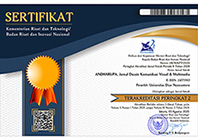Kajian Bentuk Visual Iklan (Studi Kasus Iklan Oreo Versi Bayangkan Kuberi Oreo Saat Ramadhan)
DOI:
https://doi.org/10.33633/andharupa.v2i02.1182Abstract
AbstrakTujuan dari penelitian ini adalah untuk mengetahui dan menganalisis bentuk visual dalam iklan Oreo versi “Bayangkan Kuberi Oreo Saat Ramadhan†di televisi dengan menggunakan pendekatan Estetika Media Terapan. Dari analisis yang telah dilakukan berdasarkan kontekstual visual iklan yang membagi elemen gambar menjadi lima elemen yaitu: cahaya dan warna, ruang dua-dimensi, ruang tiga-dimensi, waktu/gerakan, dan suara. Iklan Oreo “Versi Bayangkan Ku Beri Oreo Saat Ramadhan†menggambarkan bahwa Oreo sebagai brand yang sangat akrab dengan konsumen, menghadirkan momen Ramadhan yang istimewa dengan saling berbagi menikmati keajaiban dan membangkitkan kembali jiwa kanak-kanak. Pada akhir iklan terdapat adegan yang menunjukkan bahwa iklan Oreo versi ramadhan bagian dari kampanye iklan global yang sudah ada yaitu "Berbagi Keajaiban". Selain itu, Iklan Oreo Versi Ramadhan ini merupakan jenis pengingat (reminder advertising), tujuannya untuk memberitahu pelanggan tentang keberadaan merek oreo yang menawarkan karakteristik dan penggunaan yang sama. Kata Kunci: iklan, televisi, Oreo, Estetika, Ramadhan  AbstractThe purpose of this study was to determine and analyze the visual form in the Oreo ads version “Imagine Me Give Oreo During Ramadhan" on television by using the approach of Applied Media Aesthetics. From the analysis has been done based on contextual visual ads that divides the picture elements of video ads in five elements namely: light and color, the space of two-dimensional, three-dimensional space, time/motion and sound. The Oreo ads version "Imagine Me Give Oreo During Ramadhan" illustrates that the Oreo as a brand is very familiar with the consumers, presenting the moment of Ramadan special by sharing experience the magic and rekindle the spirit of childhood. At the end of the ads is contained scenes show that this Ramadhan version Oreo ads is part of a global advertising campaign that already exists is "Sharing Miracles". In addition, this Ramadhan version Oreo ads is a kind reminder (reminders advertising), aim to inform customers about the existence of Oreo brand still offers characteristics, and the same usage. Keywords: advertising, television, Oreo, Aesthetic, RamadhanReferences
Asemah, Ezekiel S., Edegoh, Leo O.N. dan Ogwo, Comfort A.. 2013. Utilisation Of Aesthetics In Television Advertising. Asian Journal Of Socialsciences And Humanities, Vol 2 No2
Kasali, Rhenald. 2007. Manajemen Periklanan, Konsep dan Aplikasinya di Indonesia. Jakarta: Pustaka Utama Grafiti. 121-122
Kothler, Philip. 2006. Marketing management. New Jersey: Pearson Education. 544
Kurtz, David L. 2008. Contemporary Marketing. Mason: South-Western. 527
Paul, Copley. 2004. Marketing Communications Management: Concepts And Theories, Cases And Practices. Burlington: Elsevier.
Pride, William M. dan Ferrell, O. C. 2009. Foundations Of Marketing. Boston: Houghton Mifflin Company. 423
Sulaiman, Annas Marzuki, dan Murtana, I Nyoman. 2015. Strategi Visual Iklan Televisi Kuku Bima Energi Produksi Pt. Sido Muncul Semarang. Gelar, vol 3, no 1: UPT Penerbitan ISI Surakarta. 80-89
Sutopo, H.B. 2006. Metodologi penelitian kualitatif: dasar teori dan terapannya dalam penelitian. Surakarta: Sebelas Maret University Press. 41
Wikipedia. 2016. https://id.wikipedia.org/wiki/Oreo diakses pada tanggal 8 Agustus 2016.
Zettl, Herbert. 2014. Sight Sound Motion: Applied Media Aesthetics, Boston: Cengage Learning. 3-4
Downloads
Published
Issue
Section
License
Copyright (c) 2016 ANDHARUPA: Jurnal Desain Komunikasi Visual & Multimedia

This work is licensed under a Creative Commons Attribution 4.0 International License.
Authors who publish with this journal agree to the following terms:
- Authors retain copyright and grant the journal right of first publication with the work simultaneously licensed under a Creative Commons Attribution License that allows others to share the work with an acknowledgment of the work's authorship and initial publication in this journal.
- Authors are able to enter into separate, additional contractual arrangements for the non-exclusive distribution of the journal's published version of the work (e.g., post it to an institutional repository or publish it in a book), with an acknowledgment of its initial publication in this journal.
- Authors are permitted and encouraged to post their work online (e.g., in institutional repositories or on their website) prior to and during the submission process, as it can lead to productive exchanges, as well as earlier and greater citation of published work (See The Effect of Open Access).















